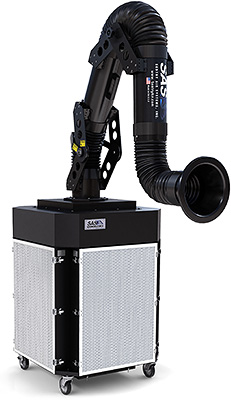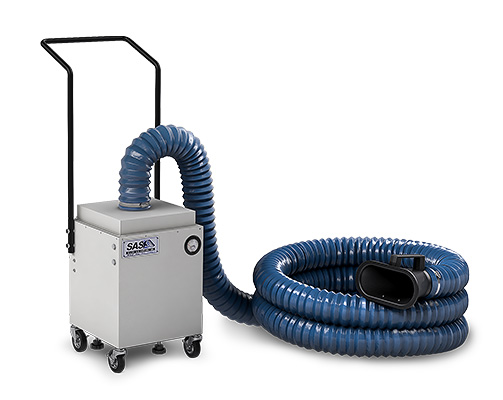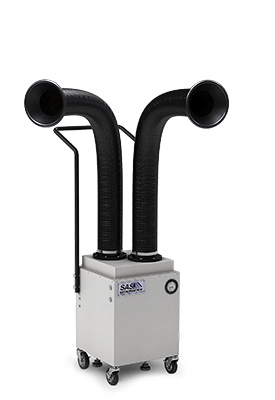Hexavalent Chromium
Hexavalent chromium exposure can result in long-lasting health effects from the inhalation of welding fumes. When welding, the application of heat creates fumes that without protection can easily be inhaled by an operator. Hexavalent chromium fumes are produced from the welding of stainless steel, chrome alloys, and chrome coated metals. Employers should take precautions to reduce employee exposure through the use of welding fume extractors to protect respiratory and overall long term employee health.
CR(VI)
When heated, chromium-containing metal creates fumes that oxidize or form the valence state of hexavalent chromium (Cr(VI)). The amount of exposure to Cr(VI) depends on the amount of chromium in the metal as well as the type of welding process. In the steel industry, stainless steel and chromium alloys contain about 11.5 – 30% chromium by weight. Industrial processes widely utilize stainless steel due to its corrosion resistance and durability. Certain welding processes, such as shielded metal arc, have been shown in research studies to produce higher amounts of Cr(VI) fumes.

Industrial
Sentry Air Systems offers a wide variety of chemical fume extraction equipment for the removal and purification of chemical fumes and vapors to assist in protecting the respiratory zone of those working with hazardous compounds and solutions. Typical applications include solvent-based cleaning or rinsing, formaldehyde, epoxies and resins, plastic bonding and gluing, touch-up painting, melting plastics, acid etching and a variety of applications involving chemical and solvent fumes, vapors, and chemical dusts.

Python Portable
The Python Portable Floor Sentry combines quiet operation, energy-efficient technology, and a unique design for highly effective fume extraction. This fume extractor is best used in hard-to-reach applications where a long hose is needed [i.e. tank welding]. The included 12-foot long (optional 25-foot hose also available), flame-retardant flex hose features a magnetic capture hood with a handle that enables the operator to attach it to a surface without having to manually hold the hose in place while capturing dust, smoke, and/or fumes.
Other features of this system include quiet operation, heavy-duty casters for convenient mobility, and high efficiency filtration. Filtration media is selected depending on the application being performed. Typical media includes: HEPA [up to 99.97% efficient on particles 0.3 microns and larger, ASHRAE [up to 95% efficient on particles 0.5 microns and larger], Activated Carbon, and specialty-blended filter media [i.e. Acid Gas, Mercury, Aldehyde, Ammonia]].

Portable
The Portable Floor Sentry fume extractor is a safety engineering control used for the capture and filtration of airborne contaminants. This source-capture fume extractor features heavy-duty casters for easy mobility, a flame-retardant and self-supportive flex arm, a small footprint, and high-quality filtration media.
Several filter media options are available for this unit and include: HEPA filtration [up to 99.97% efficient on particles 0.3 microns and larger, ASHRAE filtration [up to 95% efficient on particles 0.5 microns and larger], Activated Carbon, and specialty-blended filter media [i.e. Acid Gas, Mercury, Aldehyde, Ammonia]. The Portable Floor Sentry Fume Extractor allows multiple filter media to be housed inside the filter chamber for applications that emit both particulates and fumes.

Multi-Operator
Sentry Air Systems' fume extraction units are modular and can be easily equipped with additional accessories, including extra flex arms for multiple operator applications. The source-capture arms on these units can be taken on and off dependent upon the user's needs. Accessories, like end caps, are available to block inlet ports at the base of the unit if all flex arms are not required for operation.
Multi-Operator fume extractors are uniquely designed to provide portable fume extraction to two or more operators simultaneously. Two (up to 20) flame-retardant, self-supportive flex arms provide equal suction at all inlets, which directs contaminants into the patented air filtration system.
Is Hexavalent Chromium Toxic?
Hexavalent chromium is a toxic form of chromium that can lead to damaging health effects due to the high absorbability factor, unstable state, and carcinogenic properties. Once hexavalent chromium enters the body, it reduces to a more stable form creating free radicals that damage DNA, cells, and proteins. Free radicals in the body cause oxidation stress and possible DNA mutations leading to cancer.
Hexavalent Chromium Health Effects
The International Agency for Research on Cancer (IARC) identifies hexavalent chromium as carcinogenic to humans. Exposure to hexavalent chromium mainly causes lung cancer but can also generate growth of other types of cancer such as sinonasal, oral, and esophageal. Once hexavalent chromium penetrates the lungs, it can enter the bloodstream causing damage and other possible cancer risks to vital organs such as the liver. The cancer risk from occupational exposure to hexavalent chromium depends on the intensity of the exposure, duration, and personal health of the welder. Full-time or project welders exhibit higher risks of developing cancer than part-time workers. Welders with asthma showed a slightly elevated cancer risk when compared to healthy workers.
Other than cancer, exposure to hexavalent chromium creates irritation in the nose and throat, and nose bleeds. Sinus and nasal symptoms need to be monitored to prevent the development of cancer. People exposed to hexavalent chromium can gain an allergy or sensitivity leading to wheezing, shortness of breath, bronchitis, and asthma. Also, exposure to hexavalent chromium can damage the skin, eyes, kidney, and liver as well as provoke pulmonary congestion, abdominal pain, and teeth yellowing and irritation.
Workplace Health and Safety
OSHA enforces strict regulations regarding worker exposure to hexavalent chromium in several industries; and, subsequently established stringent regulations for workers who are potentially exposed to it in the general, construction, shipyard, and marine terminal industries. In addition, OSHA requires employers to protect employees’ health from inhalation or direct contact with hexavalent chromium fumes, as lifelong health effects can result from unprotected overexposure to hexavalent chromium fumes.
According to OSHA, common processes that can lead to the inhalation of airborne Hexavalent Chromium (dust, fume, or mist) include:
- Performing hot work and welding on stainless steel, high chrome alloys, and chrome-coated metal
- Applying and removing chromate-containing paints and other surface coatings
- Producing chromate pigments, dyes, and powders (i.e. chromic acid and chromium catalysts)
Hexavalent Chromium Exposure Limits
All employers whose employees could potentially be exposed to hexavalent chromium should conduct sampling to determine the level of exposure. The Permissible Exposure Limit (PEL) for hexavalent chromium is 5 micrograms per cubic meter of air (5µg/m3). The “Action Level” is 2.5µg/m3 (calculated as an 8-hour TWA). Employers legally must implement engineering or work practice controls if air samples meet or exceed the action level to ensure exposure does not exceed the PEL.
Recommended Engineering Control Measures for reducing exposure to CR(VI) that exceeds the PEL include*:
- Use a material that has a lower chromium content or switch to a safer alternative
- Isolation (enclosing the source of emission)
- Change the welding process to one that produces fewer fumes
- Ventilation (i.e. use a local exhaust system or fume extractor at the source of emission)
- Personal protective equipment (PPE) such as respirators. NIOSH advises that PPE alone does not provide adequate protection against hexavalent chromium fumes.

 Made in the USA
Made in the USA